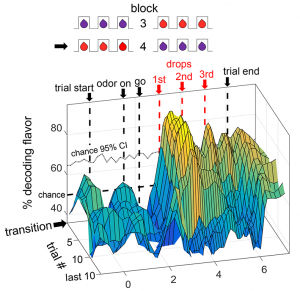 Featured Paper of the Month – March 2020.
Featured Paper of the Month – March 2020.
Midbrain dopamine neurons have long been thought to collectively signal a value prediction error, indicating whether the value of an event is greater or less than expected. A few years ago, our lab showed that these neurons also signal if an event is different than expected, without regard for value. In this paper, we build on this prior result by showing in both rats and humans that dopamine neurons or midbrain BOLD voxels, as a group, signal which unexpected event has occurred. This finding suggests that dopamine neurons are carrying much more information than previously thought, and it opens up new possibilities for how the dopamine system might be contributing to learning.
Publication Information
Dopamine neuron ensembles signal the content of sensory prediction errors. Journal Article
In: Elife, vol. 8, 2019, ISSN: 2050-084X (Electronic); 2050-084X (Linking).
